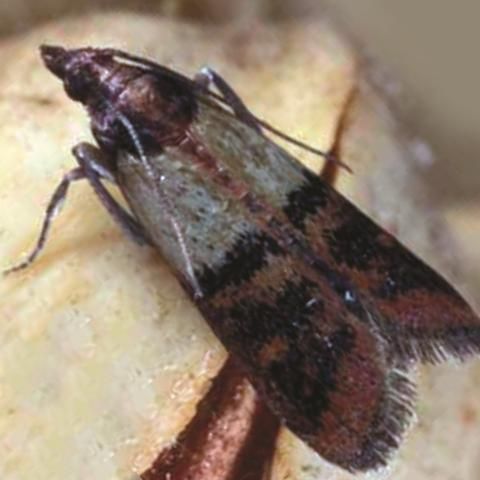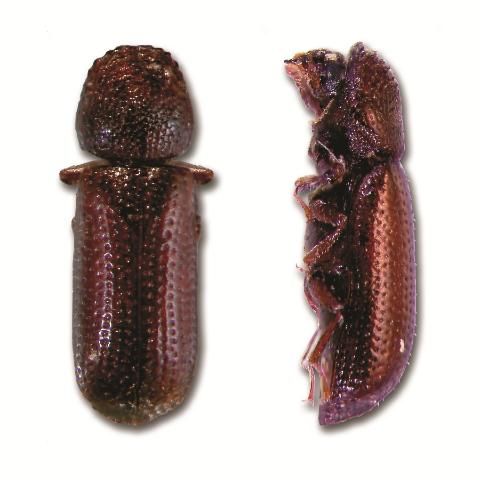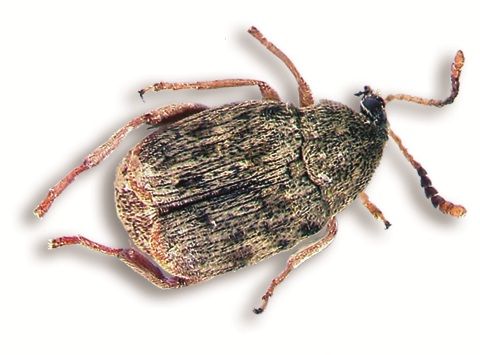
Credits: UF/IFAS
There are many species of stored food pests found at various times in food pantries. Most of these pests are introduced into our homes in infested food.
There is hardly a food item in the kitchen or food pantry that can escape being infested by some pest if it remains unused and exposed in some dark corner or drawer long enough. All items are susceptible, including spices, hot pepper, ice cream cones, and even cereals, grits, and cake mixes. Dried flower arrangements and stuffed furniture and toys often harbor infestations.
Stored food pests are economically important and are responsible for millions of dollars of loss every year in stored foods and other products. Most of the stored food pests under Florida conditions can reproduce quickly and have several to many generations in a year. Many species are active year-round under suitable conditions.
Some of the common pantry pests are flour beetles (Figure 1), sawtoothed grain beetles (Figure 2), cigarette beetles (Figure 3), drugstore beetles (Figure 3), mealworms (Figure 4), granary weevils (Figure 5), rice weevils (Figure 5), spider beetles (Figure 6), grain moths (Figure 7), sweet potato weevil (Figure 8), flour moths (Figure 9), lesser grain borer (Figure 10), bean weevil (Figure 11), warehouse beetle (Figure 12), and flat grain beetles (Figure 13). Although many different kinds of insects attack stored food, the damage they produce and the control procedures are similar.




Credit: James Castner, University of Florida









Large populations of these food pests may develop in unused or undisturbed foods that were infested when purchased. A food package that is not tightly sealed after use can also lead to infestation. From the infested food packages, the pests may spread to other exposed food. Often the only way that one knows of their presence is by discovery of an infested and infrequently used food item or the encounter of flying or crawling adults coming from the pantry shelves. Moths and beetles are often attracted to lights or windows and may indicate an infestation. The presence of stored food pests is not an indication of uncleanliness, since infestation may be brought home in purchased food.
Control
The basic fundamentals of controlling stored food pests are exclusion, regular inspections, cleaning of shelves, and chemical treatment. Sometimes an infestation can develop on bread or cracker fragments or in some undisturbed, loose flour or meal on one corner of the shelf. Keep all containers tightly closed. Put susceptible items in tight containers or screw-top jars or other sealable containers. Do not overstock shelves with products that will not be used frequently or in a short period of time. Rotate use of stored items so oldest are used first.
The first step in controlling pantry pests is to locate the source of infestation. All susceptible foods should be thoroughly inspected, and badly infested items discarded. Insects in infested foods may be killed by heat or cold if the item is of value. Infested foods may be placed in an oven at 130°F (54°C) for 30 minutes or a freezer at 0°F (-18°C) for four days to kill insects. If placed in a freezer, the commodity should be used as soon as possible since defrosting usually causes excess moisture in the item. The excess moisture could cause mold to form later. Freezing and defrosting the item in a tightly sealed plastic bag can limit condensation on the product.
To kill insects in the storage area, cabinets and shelves should be thoroughly vacuumed to pick up loose infested material and washed with warm, soapy water. Caulk cracks to limit harborage for insects. Stored food pests often hide in cracks and crevices or in corners of cabinets. These insects can be controlled using a crack-and-crevice insecticide application. Apply a residual spray to the cracks, corners, and surfaces of the shelves. Remove all food items from shelves that may become contaminated with spray. Allow the spray application to dry before replacing the food items. Be sure to remove and spray all drawers as well as the inside of the cabinets after cleaning.
Some moths and beetles readily fly to light and remain on exposed surfaces that should not be sprayed with residual insecticides. These exposed insects can be controlled with indoor space spray treatments.
Storage of grains and grain products has resulted in considerable problems with stored grain insects in homes and institutions. Whole grain can be fumigated in storage containers with carbon dioxide. Dry ice (frozen carbon dioxide) can be placed in storage containers directly on top of grain at the rate of 1/4 pound per 5-gallon container (120 g per 20 liters). The container lids should not be tightened for half an hour. After half an hour tighten lids and place the commodity in storage. At least 14 days' exposure is necessary to be certain of satisfactory control.